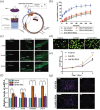Innovative Nanotechnology in Drug Delivery Systems for Advanced Treatment of Posterior Segment Ocular Diseases
- PMID: 39031809
- PMCID: PMC11348104
- DOI: 10.1002/advs.202403399
Innovative Nanotechnology in Drug Delivery Systems for Advanced Treatment of Posterior Segment Ocular Diseases
Abstract
Funduscopic diseases, including diabetic retinopathy (DR) and age-related macular degeneration (AMD), significantly impact global visual health, leading to impaired vision and irreversible blindness. Delivering drugs to the posterior segment of the eye remains a challenge due to the presence of multiple physiological and anatomical barriers. Conventional drug delivery methods often prove ineffective and may cause side effects. Nanomaterials, characterized by their small size, large surface area, tunable properties, and biocompatibility, enhance the permeability, stability, and targeting of drugs. Ocular nanomaterials encompass a wide range, including lipid nanomaterials, polymer nanomaterials, metal nanomaterials, carbon nanomaterials, quantum dot nanomaterials, and so on. These innovative materials, often combined with hydrogels and exosomes, are engineered to address multiple mechanisms, including macrophage polarization, reactive oxygen species (ROS) scavenging, and anti-vascular endothelial growth factor (VEGF). Compared to conventional modalities, nanomedicines achieve regulated and sustained delivery, reduced administration frequency, prolonged drug action, and minimized side effects. This study delves into the obstacles encountered in drug delivery to the posterior segment and highlights the progress facilitated by nanomedicine. Prospectively, these findings pave the way for next-generation ocular drug delivery systems and deeper clinical research, aiming to refine treatments, alleviate the burden on patients, and ultimately improve visual health globally.
Keywords: ROS scavenging; anti‐VEGF therapy; drug delivery; nanomedicine; posterior segment ocular diseases.
© 2024 The Author(s). Advanced Science published by Wiley‐VCH GmbH.
Conflict of interest statement
The authors declare no conflict of interest.
Figures










References
-
- Campa C., Curr. Drug Targets 2020, 21, 1194. - PubMed
-
- Heier J. S., Kherani S., Desai S., Dugel P., Kaushal S., Cheng S. H., Delacono C., Purvis A., Richards S., Le‐Halpere A., Connelly J., Wadsworth S. C., Varona R., Buggage R., Scaria A., Campochiaro P. A., Lancet 2017, 390, 50. - PubMed
-
- Baumal C. R., Spaide R. F., Vajzovic L., Freund K. B., Walter S. D., John V., Rich R., Chaudhry N., Lakhanpal R. R., Oellers P. R., Leveque T. K., Rutledge B. K., Chittum M., Bacci T., Enriquez A. B., Sund N. J., Subong E. N. P., Albini T. A., Ophthalmol. 2020, 127, 1345. - PubMed
Publication types
MeSH terms
Grants and funding
- 82271048/National Nature Science Foundation of China
- 61905130/National Nature Science Foundation of China
- 23ZR1409500/Project of Shanghai Science and Technology
- 23XD1420500/Project of Shanghai Science and Technology
- 23S11900200/Project of Shanghai Science and Technology
- 22S11900200/Project of Shanghai Science and Technology
- 2021318/EYE & ENT Hospital of Fudan University High-level Talents Program
- yg2023-06/Medical Engineering fund of Fudan University
- yg2023-206/Medical Engineering fund of Fudan University
- 2018M640145/Postdoctoral Science Foundation of China
- 2019T120106/Postdoctoral Science Foundation of China
- Program for Professor of Special Appointment (Eastern Scholar) at Shanghai Institutions of Higher Learning;
LinkOut - more resources
Full Text Sources
Medical
